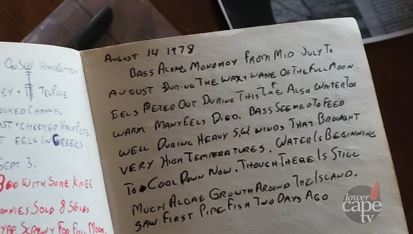
An exerpt from an eel fisherman’s diary. (Courtesy of Lower Cape TV)
Jim Harrington has great eel stories, like the time he set 25 pots in Upper Mill Pond in Brewster and caught 400 pounds. He got good money for them, too.
Harrington is willing to tell people how he caught the snake look-alike. And on camera no less.
“I would fish all over Cape Cod and I would use herring for bait. I don’t mind telling you all the old secrets because it’s a fishery that is long gone,” he said.
Harrington is part of a video exploration of the North American eel, a Lower Cape TV production, reported by Angela McNerney.
The 20-minute video delves into the hidden world of eels, which hatch in the Sargasso Sea and travel 2000 miles to the Cape to live much of their adult lives in freshwater ponds and estuaries. The catadromous species then head back to salty Sargasso toward the end of their lives to give birth and start the cycle all over again.
Joanne Burns, who fished for eels with her late husband Jay Harrington (Jim’s brother), and Brad Chase of the Division of Marine Fisheries join Harrington to offer viewers a nuanced sense of the historic fishery.
Through old photographs and memories, Burns and Harrington take viewers back to when eeling was still vibrant, in the 1970s, ‘80s and ‘90s. Eels were speared or caught in pots, which looked a bit like round lobster traps.
“Eel spearing is an art,” says Burns in the film.
Chase has been studying eels for 30 years and shared interesting facts. Eels change color based on environmental cues, and the sex of the population adapts to density; the less dense a population, the more baby eels become female. Their ability to travel thousands of miles as tiny eels continues to intrigue researchers.
There are still some eels making it to the Cape, but unlike river herring we are not seeing what could be described as even a modest recovery. Chase said that along with natural predators such as cormorants and seals, environmental degradation due to nutrient pollution may be a key hindering factor.
The video is a fascinating tale of the eel’s uniqueness, its cultural importance, and hopefully its future. Thanks to Lower Cape TV for letting us link to it here. Watch more of the non-profit newsroom’s great work here at Coast + Climate.
